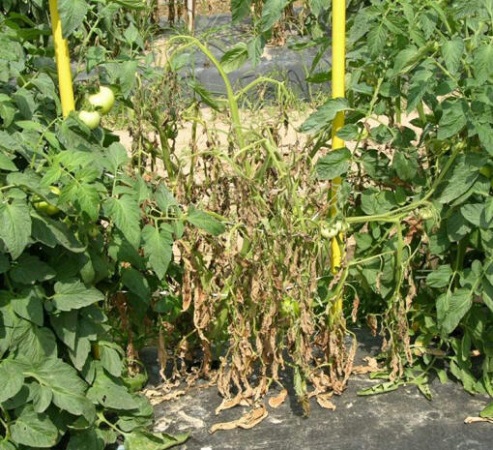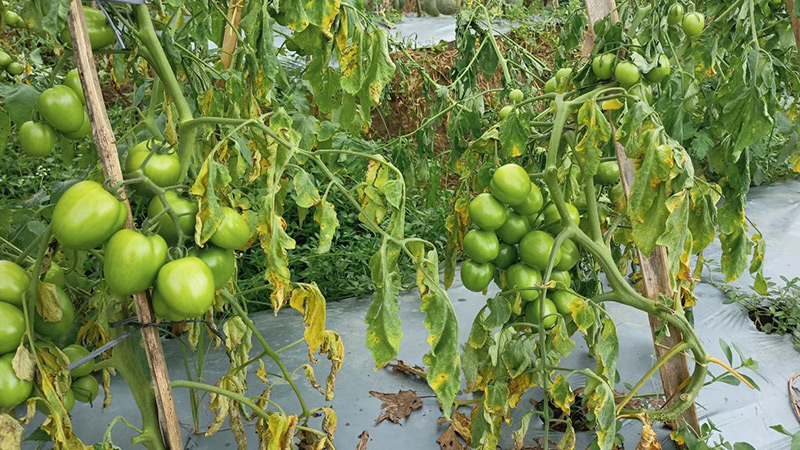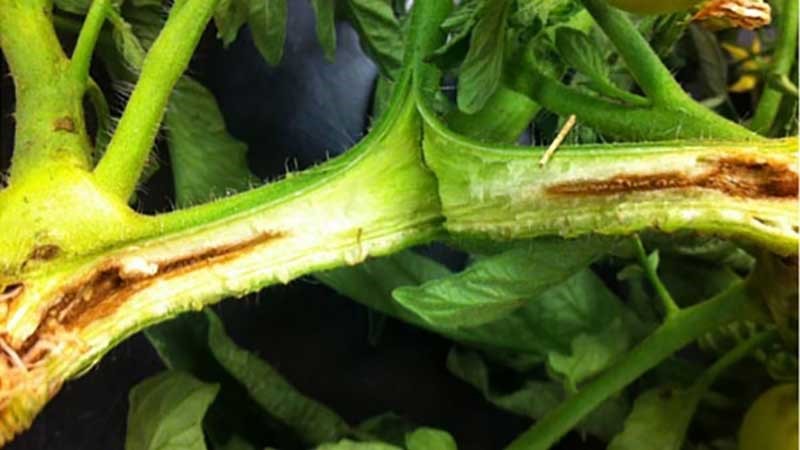
Fusarium Wilt of Tomato: Causes & Ammonium Sulfate Solutions
Fusarium wilt is one of the most common and damaging diseases in tomato farming. Caused by Fusarium fungi, this disease often thrives in poor soil conditions and high humidity. For farmers and tomato producers, identifying the causes of Fusarium wilt and effective control methods is crucial. One of the most effective strategies for managing this disease is the use of ammonium sulfate. In this article, we will explore the factors that contribute to Fusarium wilt in tomatoes and the significant role ammonium sulfate plays in controlling this disease.
Why is It Concerning?
Fusarium wilt is a fungal disease that impacts tomato plants. Due to the fungus’s ability to produce resistant spores and spread rapidly, the disease can easily infiltrate tomato fields. The initial symptoms include yellowing and wilting of leaves—especially on hot days—as well as stunted plant growth. In more advanced stages, wilting can lead to plant death.
Given the popularity of tomatoes in both local and global markets, controlling this disease is essential for maintaining plant health and ensuring sustainable production. Utilizing scientific and effective methods, including the application of appropriate fertilizers like ammonium sulfate, can enhance growth conditions and minimize damage.
Causes of Fusarium Wilt in Tomatoes
Fusarium wilt arises from a combination of environmental, management, and biological factors. Here, we examine the primary causes of this disease:
1. Improper Soil Conditions
- High Humidity: Soils with excess moisture create an environment conducive to Fusarium fungi. This is often seen with overwatering or frequent rainfall.
- Improper pH: Alkaline soil pH can hinder plant health and increase susceptibility to diseases, including Fusarium wilt.
- Nutrient Deficiency: Soils lacking in nitrogen, phosphorus, and potassium weaken plants, making them more prone to disease.
2. Agricultural Practices
- Poor Crop Rotation: Continuous cultivation of tomatoes without crop rotation leads to an accumulation of Fusarium fungi in the soil.
- Inadequate Spacing: Planting tomatoes too closely together can create moisture pockets, increasing the risk of disease.
- Use of Infected Seeds: Seeds contaminated with Fusarium fungi can introduce the disease to new fields.
3. Environmental Conditions
- Temperature: Fusarium thrives at temperatures between 77°F and 86°F (25°C to 30°C). Extremely high temperatures can exacerbate disease symptoms.
- Humidity: High levels of humidity facilitate the spread and activity of Fusarium fungi.
4. Biological Factors
- Different Races of Fusarium: Various races of Fusarium fungi exist, and the specific type can significantly influence the severity of the disease.
- Symbiotic Factors: The presence of other diseases or pests can weaken plants, making them more susceptible to Fusarium wilt.

The Role of Soil pH
Soil pH and structure play critical roles in the Fusarium wilt of tomato. A pH range of 6 to 7.5 is optimal for preventing disease, as it reduces Fusarium activity. While acidic conditions can lower nematode pests and certain fungi, they may also make some plants more vulnerable to diseases. Conversely, alkaline soils (with a pH above 7.5) often provide favorable conditions for Fusarium growth, allowing the fungi to multiply and harm plants.
Soil structure is another key factor in Fusarium infection. Compacted soils reduce airflow and increase moisture levels, which can enhance Fusarium activity, as roots struggle to breathe and absorb water effectively. Ample organic matter and nutrients in the soil bolster plant health and resilience against diseases. Nutrient-poor soils can undermine plant strength, making them more susceptible to Fusarium wilt.
To mitigate the incidence of Fusarium in tomato fields, managing soil pH and structure is essential. Regular soil testing, pH adjustments, and improving soil structure through organic matter addition can help maintain plant health and reduce disease risk.
What Are the Symptoms of Fusarium Wilt of Tomato?
Early detection of Fusarium wilt in tomatoes is vital for effective disease management and preventing further damage. The symptoms are generally easy to recognize in the early stages. Here are some of the most significant signs of Fusarium wilt:
- Yellowing of Leaves: One of the first signs of Fusarium wilt is the yellowing of the lower leaves on the plant. This yellowing typically begins at the edges of the leaves and moves toward the center.
- Wilting During Hot Days: Plants affected by Fusarium wilt often wilt significantly during the hottest parts of the day but may appear normal again in the morning or at night. This symptom results from water loss and a reduced ability to absorb moisture from the soil.
- Abnormal Leaf Drop: The dropping of leaves from tomato plants is a clear indicator of severe weakness, which is a hallmark symptom of Fusarium wilt.
- Changes in Stem Color and Texture: The stems of infected tomato plants may turn brown or black and could soften or rot at their lower sections.
- Root Damage: If Fusarium infection is suspected, it’s crucial to examine the roots. Infected roots may rot or darken due to their inability to effectively absorb water and nutrients.
- Reduced Quality of Produce: Tomatoes impacted by Fusarium wilt are often smaller, lack flavor, and are of inferior quality.

Control Methods
Managing Fusarium wilt in tomatoes requires a combination of preventive and treatment strategies. By employing the right techniques and improving growth conditions, farmers can help prevent this disease and maintain the quality and quantity of their harvest. Here are some effective methods for controlling Fusarium wilt:
- Crop Rotation and Diversity: Growing a variety of plants can help reduce the buildup of pathogens in the soil.
- Use Healthy, Disease-Resistant Seeds: Choosing seeds that are resistant to Fusarium can significantly lower the risk of infection.
- Irrigation Management: Avoiding overwatering and utilizing drip irrigation can help reduce soil moisture levels, thereby preventing disease.
- Improving Soil Structure: Incorporating compost and organic fertilizers can enhance soil structure and nutrient content, which boosts plant health and resilience against diseases.
- Weed Control: Weeds can serve as hosts for Fusarium. Removing them can help decrease sources of infection.
- Use of Fungicides: In cases of infection, employing effective fungicides is necessary to manage Fusarium. The selection of fungicides should be based on scientific recommendations and relevant guidelines.
- Optimizing Soil pH: Conducting soil tests and adjusting pH levels to fall between 6 and 7.5 can help minimize the incidence of Fusarium.

The Role of Ammonium Sulfate in Controlling Fusarium Wilt in Tomato
Ammonium sulfate is an important nitrogen fertilizer that plays a significant role in managing Fusarium wilt in tomatoes. Here’s how ammonium sulfate contributes to control efforts:
- Improving Soil Structure: Ammonium sulfate enhances soil structure and increases its capacity to hold water and nutrients, which helps plants thrive under stress.
- Adjusting Soil pH: This fertilizer can lower soil pH, creating an environment that hinders Fusarium growth and reduces the activity of pathogenic fungi.
- Strengthening Plant Immunity: The nitrogen in ammonium sulfate boosts the plant’s immune system, making it more resilient against fungal attacks and other pathogens.
- Promoting Plant Growth: Ammonium sulfate serves as a rich nitrogen source, which is essential for plant growth and development. It helps increase leaf and root growth.
- Facilitating Nutrient Absorption: This fertilizer can improve the uptake of other vital nutrients, such as potassium and phosphorus, which are crucial for overall plant health and disease resistance.
Practical Tips for Using Ammonium Sulfate
To maximize the benefits of ammonium sulfate as a nitrogen fertilizer, proper application timing and techniques are essential. The optimal time to apply ammonium sulfate is before planting, as this allows plants to absorb the necessary nitrogen during their early growth stages. It can also be applied during the plant’s active growth phase, particularly during flowering and fruiting, to meet increased nitrogen demands.
The amount of ammonium sulfate needed varies based on soil type and nutrient status, with a general recommendation of 100 to 200 kg/ha for tomatoes. Before application, conducting a soil test is advisable to determine the plant’s exact nitrogen needs.
Spread ammonium sulfate evenly across the soil surface, then incorporate it to the appropriate depth through plowing or mixing. Following application, ensure adequate irrigation to help the fertilizer penetrates the soil, making it readily available for plant uptake. Ammonium sulfate can be combined with fertilizers that contain phosphorus and potassium to maintain balanced soil nutrients, promoting overall plant health.
Avoid fertilizing when the soil is overly wet or when rain is forecasted, as this can lead to nutrient runoff and waste.